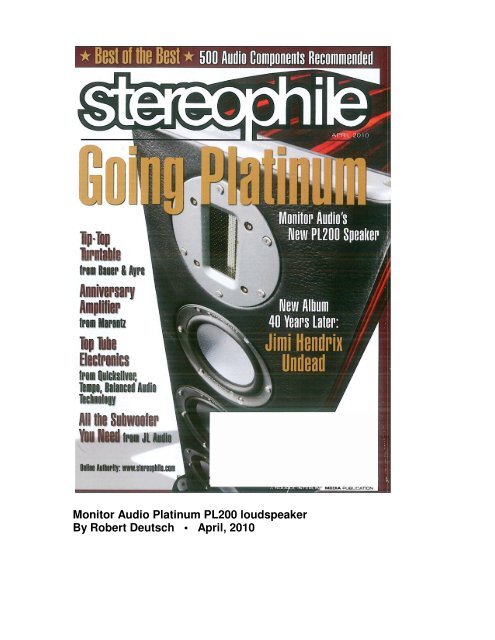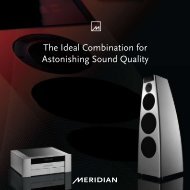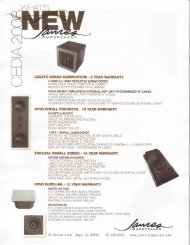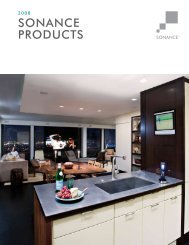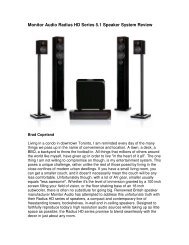Monitor Audio Platinum PL200 loudspeaker By Robert Deutsch • April 2010
Monitor Audio Platinum PL200 loudspeaker By Robert Deutsch ...
Monitor Audio Platinum PL200 loudspeaker By Robert Deutsch ...
Create successful ePaper yourself
Turn your PDF publications into a flip-book with our unique Google optimized e-Paper software.
<strong>Monitor</strong> <strong>Audio</strong> <strong>Platinum</strong> <strong>PL200</strong> <strong>loudspeaker</strong><br />
<strong>By</strong> <strong>Robert</strong> <strong>Deutsch</strong> <strong>•</strong> <strong>April</strong>, <strong>2010</strong>
A few years ago, I had a phone call from a marketing organization. I was asked,<br />
as a member of the audiophile press, to participate in a survey dealing with the<br />
"images" of various brands of <strong>loudspeaker</strong>s.<br />
I declined to participate in the<br />
survey—Stereophile editorial<br />
policy does not allow writers to<br />
act as consultants, and this was<br />
tantamount to being a<br />
consultant, albeit an unpaid one.<br />
However, if one of the brands in<br />
the survey had been <strong>Monitor</strong><br />
<strong>Audio</strong>, my answers would not<br />
have been terribly helpful: I had<br />
no very clear "image" of <strong>Monitor</strong><br />
<strong>Audio</strong> speakers. British, wellmade,<br />
uses gold-anodized<br />
dome tweeters—that's about all<br />
I could have said about them. I<br />
had not listened to <strong>Monitor</strong><br />
speakers for any length of time.<br />
My impressions were vaguely<br />
positive, but nothing to make me<br />
think that these were speakers I<br />
simply must review.<br />
My impression of <strong>Monitor</strong> <strong>Audio</strong> speakers changed at the 2007 Montreal Festival<br />
Son & Image. At a show at which many excellent speakers were displayed, the<br />
demonstration of <strong>Monitor</strong>'s <strong>Platinum</strong> PL300s was characterized by sound that I<br />
described in my show report as being "arrestingly lifelike." I made a mental note<br />
to myself to consider reviewing these speakers, but, what with this and that, by<br />
the time I got around to taking steps to arrange a <strong>Monitor</strong> <strong>Audio</strong> review, the year<br />
was 2009 and the new speaker in the <strong>Platinum</strong> line was the <strong>PL200</strong>. This speaker<br />
has much the same technology as the PL300, but in a more compact package<br />
and at a lower price ($8000/pair)—a combination that always appeals to me. And<br />
a demo of a pair of <strong>PL200</strong>s at the 2009 Montreal show was most convincing.<br />
This time, I made sure that reviewing the <strong>PL200</strong> was not a "Think about . . ." but<br />
a "Do!"
Description and design<br />
Remember the advertising slogan for Clairol's Nice 'n Easy, "The closer he gets,<br />
the better you look"? Perhaps a wee sexist in today's world, but if <strong>Monitor</strong> <strong>Audio</strong><br />
were to borrow this slogan, they could well adapt for the<br />
advertising of the <strong>Platinum</strong> <strong>PL200</strong>. From a distance, it looks<br />
much like any other floorstander. But get closer, and you'll see<br />
that the fit and finish are of a quality far higher than the norm.<br />
The wood finish (Santos Rosewood on the review samples) is<br />
impeccable: smooth, with a gloss that indicates multiple coats<br />
of varnish, each coat (of 11, I'm told) polished to perfection.<br />
Joins in the veneer are invisible. The front baffle is finished in<br />
leather—not just any leather, mind you, but "Strathspey<br />
leather," selected for its acoustical properties as well as for its<br />
appearance.<br />
The drivers are on the exotic side: the midrange and bass<br />
have metal-covered cones, and the tweeter is a ribbon rather<br />
than the ubiquitous dome. The midrange and bass cones are<br />
made of a honeycombed Nomex combined with <strong>Monitor</strong>'s<br />
Ceramic-Coated Aluminum Magnesium (C-CAM) alloy,<br />
forming a rigid structure with low mass. C-CAM is also used in<br />
the construction of the ribbon tweeter, whose frequency<br />
response is claimed to extend to 100kHz. Although this is well<br />
above what's normally considered to be the upper limit of human hearing (and<br />
the CD format is bandwidth-limited to 22kHz), there is some evidence that, at<br />
least with wide-bandwidth sources, ultrasonic response may improve the sense<br />
of reality of the reproduction. Even if the audibility or utility of the ultrasonic<br />
response is questionable, there is still the argument that a tweeter whose<br />
response extends far beyond the range of human hearing may perform better in<br />
the audible range. Oh, and in case you were wondering, other than in the finish<br />
of their WBT binding posts, the <strong>Platinum</strong> <strong>PL200</strong> contains no platinum.<br />
I couldn't find much information about the <strong>PL200</strong>'s crossovers in the product<br />
literature or on <strong>Monitor</strong> <strong>Audio</strong>'s website, but Dean Hartley, the company's head<br />
designer, told me that the low-pass bass-driver crossover and both the high- and<br />
low-pass crossovers on the midrange are 12dB/octave, and that the tweeter is<br />
protected by an 18dB/octave crossover. Crossover components include highspec<br />
foil capacitors and air-core inductors; the internal wiring is pure silver.
The fine-furniture finish of the <strong>PL200</strong>'s cabinet hides a complex, high-tech<br />
construction. Multiple layers of bonded MDF form a multicurved shell; steel bolts<br />
tie the front and rear panels to a "pinhole" bracing structure. A tool is provided for<br />
tightening the bolts, which can loosen during shipping. Under the leather, the<br />
front baffle is made of something called Anti Resonant Composite (ARC), "a<br />
thermo-set polymer loaded with minerals." The midrange driver occupies its own<br />
sealed, tapered enclosure within the main enclosure. The bass is ported, but,<br />
again, the design is unique, and called HiVe II: a straight-rifled aperture that's<br />
claimed to be able to move air in and out more quickly than conventional<br />
designs.<br />
The <strong>PL200</strong>'s integral plinth is also made of ARC, and has feet that are adjustable<br />
for leveling. (A spirit level is provided.) The plinth houses two sets of WBT<br />
terminals for optional biwiring. I single-wired the <strong>Monitor</strong>s.<br />
<strong>Monitor</strong> <strong>Audio</strong> is owned and managed in the UK, but since 2004 its<br />
manufacturing facilities have been consolidated in China. ("The best move we<br />
ever made," says Dean Hartley.) According to Hartley, parts for the <strong>PL200</strong> are<br />
sourced or made with the objective of achieving the highest quality and<br />
tolerances. The tweeter itself—the manufacturer of which requires extremely tight<br />
tolerances—is made in Malaysia. The final assembly is done in <strong>Monitor</strong> <strong>Audio</strong>'s<br />
factory in China, with QC supervised and inspected by <strong>Monitor</strong> <strong>Audio</strong>'s own staff.<br />
System and setup<br />
In considering reviewing a pair of speakers, I first must make sure that I have an<br />
amplifier that can drive them. Though the last speaker I reviewed, the<br />
Avantgarde Uno Nano (July 2009), thrives on low-powered tube amplification, a<br />
glance at the <strong>Platinum</strong> <strong>PL200</strong>'s specifications told me that this speaker would<br />
require something else. <strong>Monitor</strong> <strong>Audio</strong> recommends an amplifier with a minimum<br />
output of 100Wpc. But with a speaker of the <strong>PL200</strong>'s pedigree, those shouldn't<br />
be just any kind of watts—I'd want to use an amplifier good enough that its sound<br />
quality would not compromise the speaker's performance. Which one?
The solution presented itself when I remembered that <strong>Monitor</strong> <strong>Audio</strong> has<br />
exhibited very successfully with Simaudio electronics. A loan<br />
of the Moon Evolution W-7 amplifier (150Wpc) was arranged,<br />
and the folks at Simaudio also suggested that I use the<br />
matching Moon Evolution P-7 preamplifier as well—which, in<br />
combination with my Ayre CX-7e MP CD player, would result in<br />
a fully balanced system. Well, why not? Besides, the P-7 and<br />
CX-7e MP are both listed in Class A of Stereophile's<br />
"Recommended Components," and the W-7 is a lowerpowered<br />
version of the Moon W-8, another Class A denizen.<br />
In terms of electronics, I was pretty sure I'd be in good shape.<br />
But my reviewing system still had not fully evolved. I looked<br />
at the interconnects I had on hand and realized that I lacked<br />
the requisite two identical balanced pairs: one pair for CD<br />
player to preamp, the other from preamp to power amp. In<br />
fact, the interconnects I'd been using were a bit of a<br />
hodgepodge, and some of them were no longer made—<br />
perhaps it was time to upgrade. But there are lots of<br />
interconnects out there, and I had no interest in trying all<br />
sorts of models from different manufacturers. The cables I've<br />
used more than any other are from Nordost: Valhalla speaker<br />
cable, still current in their line; and Quattro Fil interconnect,<br />
discontinued some time ago. My positive experience with them led me to think<br />
that Nordost would be the logical choice. I talked to Nordost's vice-president of<br />
marketing (and sometime audio scribe), Roy Gregory, who offered to loan me<br />
some Valhalla interconnects and power cables to supplement the Valhalla<br />
speaker cables I already had. Replacing my stock Linn Ittok tonearm cable with<br />
Nordost's Frey (the Valhalla is too stiff for the Linn turntable's suspension)<br />
completed the Nordost cable loom. (See Art Dudley's discussion of the "loom"<br />
concept in "Listening" in the December 2009 issue.)<br />
Over the years, I've found that speakers sound best when placed within a fairly<br />
circumscribed area, away from the front and sidewalls and along the 16' length of<br />
my 14' by 16' by 7.5' room, forming close to the classic 60° angle,when perceived<br />
from the listening position, or even a bit wider. (I like a wide soundstage.) Within<br />
that area, moving the speakers by small increments from the front and sidewalls<br />
and varying their toe-in allows some tuning of the tonal balance and optimizing<br />
the width and depth of the soundstage.<br />
Sheldon Ginn of Kevro International, <strong>Monitor</strong>'s North American distributor, came<br />
by to help me with the setup. He tightened the bolts that keep the enclosure rigid,<br />
and adjusted the feet so that the spirit level indicated that both speakers were<br />
level. Together, we moved the speakers around a bit until the soundstage came<br />
into good focus. I was told that my review samples had had a fair amount of<br />
break-in time, but more never hurts—whenever my wife and I were away from
home, I programmed <strong>Monitor</strong> <strong>Audio</strong>'s break-in CD (supplied with my review<br />
samples) for repeat play. Over a period of several weeks, the bass improved and<br />
the sound generally seemed to become more relaxed—but since the audio<br />
electronics and the cables were new in the system as well, I can't definitely<br />
attribute this change to speaker break-in alone.<br />
As I kept listening to the <strong>PL200</strong>s after the initial setup, I had the feeling that<br />
although their soundstage was fine, the tonal balance was a little bass-shy. I<br />
moved the speakers a few inches toward the wall behind them (too close and<br />
you exacerbate room modes), which resulted in a better balance of the bass with<br />
the rest of the range. The <strong>PL200</strong>s come with metal grilles that conveniently<br />
attach with magnets. I compared their sound with the grilles on and off, and<br />
found the focus to be better with the grilles off, so that's how I listened to them.<br />
(This was also Sheldon Ginn's recommendation.)<br />
Sound<br />
For me, the two most important attributes that define <strong>loudspeaker</strong> quality are<br />
resolution and transparency. <strong>By</strong> resolution I mean the ability of a speaker to<br />
communicate the fine details of the music encoded in the recording, while<br />
transparency refers to a speaker's ability to present a "clear window" on the<br />
music, free of distortions and colorations. These characteristics are important for<br />
any audio component, but are particularly important—and particularly difficult to<br />
achieve—in a mechanical product like a <strong>loudspeaker</strong>. Some speakers that offer a<br />
detailed presentation also have a distinctive sonic personality that keeps<br />
reminding you that you're listening to speakers, not live music. Other speakers<br />
are pleasantly "musical," with little in the way of a distinctive "speaker sound," but<br />
gloss over the music's finer details: such speakers are high in transparency but<br />
low in resolution. It's hard to get both in the same speaker. My Avantgarde Uno<br />
Nanos have very high resolution, but they also have a distinctive sonic<br />
personality—the well-known "horn coloration," which, while lower in the Uno<br />
Nano than in other horns, is still audible.
My usual test of resolution is to play highly familiar recordings, listening for any<br />
details I had not been aware of before. One disc that I find very useful for this is<br />
All Star Percussion Ensemble (CD, Golden Strings GS CD 005), an early digital<br />
recording (1982) selected in 1993 by Home Theater magazine's Thomas J.<br />
Norton, then my colleague at Stereophile, as a "Record To Die For." It's a sonic<br />
spectacular in the best sense: "balance is superb, detailing is precise and at<br />
times striking, dynamics wide, and the soundstage is particularly broad and<br />
deep," to quote TJN. I don't know what equipment Tom used to come up with<br />
that assessment, but I've listened to this recording many, many times, and<br />
through the <strong>PL200</strong>s I heard details of orchestration that simply had not been<br />
apparent before. For example, in the arrangement of Pachelbel's Canon in D, I<br />
noticed for the first time that a percussion instrument enters the fray (at 2:42 into<br />
track 3) making "clucking" sounds. Could I have heard it through other speakers<br />
if I'd listened more attentively? Perhaps. All I can say is that with the <strong>PL200</strong>s in<br />
this system, the presence of this instrument was very obvious, and an effective<br />
part of director Harold Farberman's arrangement.<br />
The <strong>PL200</strong> also sailed through my other tests of resolution, such as revealing the<br />
editing glitches in Sylvia McNair's Sure Thing: The Jerome Kern Songbook (CD,<br />
Philips 442 129-2). These details didn't sound exaggerated, like a digital photo<br />
with the sharpening control turned up too high; they were just there.
Another way to assess a speaker's resolution is to listen to how it reproduces any<br />
changes in sound produced by changes in other components or tweaks. This<br />
opportunity presented itself when I was replacing my interconnects and AC cords<br />
with Nordost Valhalla products. Because I wasn't doing a cable review as such, I<br />
didn't spend a lot of time switching cables back and forth, but I did listen carefully<br />
before and after each swap (having first unplugged and replugged the original<br />
cable, to make sure that any sonic difference was not merely a function of<br />
cleaning the contacts, a natural byproduct of this process). In every instance, I<br />
could hear an improvement. The high resolution of the <strong>PL200</strong>s—and, of course,<br />
of the rest of the system—allowed me to hear differences that might have been<br />
obscured with other speakers. What most surprised me was that substituting the<br />
Nordost Valhalla power cords for the better-than-average (albeit an obsolete<br />
model) PS <strong>Audio</strong> cords at the input to the PS <strong>Audio</strong> Power Plant Premier<br />
produced a significant improvement in clarity and dynamics. But the Power Plant<br />
Premier actually regenerates the AC supply—why should the cable between the<br />
wall outlet and the Power Plant make a difference? Search me . . .<br />
Soundstaging was simply superb: wide, deep, and precise in the spatial definition<br />
of sonic images on the stage. The soundstage was also quite high, seemingly<br />
located above the speakers. I would expect this from a taller speaker, and/or one<br />
that has an extra, upward-facing tweeter—but, of course, the <strong>PL200</strong> isn't and<br />
doesn't. I really liked this effect—it made me feel as if I were sitting in the front of<br />
the orchestra section, rather than farther back or in the balcony.<br />
When it came to transparency—defined as an absence of coloration or a<br />
distinctive "speaker sound" added to the music being reproduced—the <strong>PL200</strong><br />
once again performed like a champ. Colorations created by cabinet resonances<br />
can be problematic with floorstanding <strong>loudspeaker</strong>s, but in the case of the <strong>PL200</strong><br />
were conspicuous by their relative absence. The midrange was essentially<br />
neutral, which was effective in communicating the distinctive characteristics of<br />
the voices of various singers; they sounded, as I noted in my <strong>April</strong> 2007 show<br />
report on the PL300, "arrestingly lifelike."
To the extent that the <strong>PL200</strong> had a distinctive sound, it was in the direction of a<br />
slight brightness. If you consider tonal balance to be on a continuum, with<br />
warm/lush/soft at one end and airy/cool/bright at the other, then the <strong>PL200</strong> was<br />
closer to the latter. The treble was highly extended—my hearing falls just slightly<br />
short of extending to 100kHz, so I'll have to take <strong>Monitor</strong>'s word for that spec—<br />
and very clean, to the benefit of the sound of percussion instruments. In fact, at<br />
least some of what I heard as extra brightness might have been due to other<br />
components in the system. This is a perennial problem in evaluating the<br />
contribution of one component in a system, which is why it is best to switch out<br />
only one at a time. The Nordost Valhalla cables, which offer superb neutrality and<br />
resolution, aren't known for being forgiving or sounding soft. The Simaudio<br />
preamp and power amp are excellent products, but in John Atkinson's review of<br />
the Moon Evolution P-7 in the March 2009 Stereophile he noted that it had a<br />
"slightly more forward, slightly more robust" sound than his reference preamp,<br />
the Mark Levinson No.380S; that may have been part of what I heard.<br />
I also briefly drove the <strong>PL200</strong>s with tube electronics—Convergent <strong>Audio</strong><br />
Technology's SL-1 Renaissance preamp and PrimaLuna's ProLogue Seven<br />
power amplifiers. The results were interesting: The sounds of voices and musical<br />
instruments took on a decidedly softer, more rounded quality that was most<br />
attractive—more "musical," if you like—but the resolution was a notch lower, and<br />
the bass was not as tight or extended. On balance, I preferred the Simaudio<br />
Moon Evolution combo of P-7 and W-7.<br />
With the Simaudio electronics, the <strong>PL200</strong>'s bass was nearly as impressive as its<br />
treble. Played at a fairly high level, the bass drums and synthesizer on Mickey<br />
Hart's Planet Drum (Rykodisc RCD 10206) came over with enough impact to not<br />
sound wimpy, and the bass had excellent clarity and articulation. The doublebass<br />
line in "I Won't Dance," from Sylvia McNair's Sure Thing, was easy to follow<br />
without overwhelming the singer. As one might expect given the <strong>PL200</strong>'s size<br />
and driver complement, the extreme lows (20–30Hz) weren't there—the<br />
speaker's claimed low-end limit is 35Hz, which seems about right—but the bass<br />
that was there held up to fairly high levels without sounding strained. Those who<br />
want more extended, more powerful bass might consider <strong>Monitor</strong>'s matching<br />
PLW-15 powered subwoofer—or the PL300, whose larger cabinet contains,<br />
along with the same midrange and tweeter as the <strong>PL200</strong>, a pair of 8" rather than<br />
6.5" woofers.<br />
Which leaves us with dynamics—another of the <strong>PL200</strong>'s strengths. With the<br />
appropriate recordings the speakers sounded "quick," and music had a subtle<br />
ebb and flow that resembled that real thing. Many speakers must be driven to<br />
high levels to get much of a sense of dynamic contrasts—not so the <strong>PL200</strong>.<br />
Some of my most memorable times with the <strong>Monitor</strong>s were when I listened at<br />
night, with the volume set to what most people would consider a background<br />
level. The <strong>PL200</strong> maintained its resolution at this level—even the softest musical<br />
passages had the appropriate dynamic variations. In this respect, the <strong>PL200</strong>
esembled the original Quad and KLH 9 speakers that I used to have. The<br />
<strong>PL200</strong>s were also able to play pretty loud—at levels that would have resulted in<br />
the Quads or the KLH 9s going up in smoke. At very high levels, the <strong>PL200</strong>s<br />
couldn't match the sense of dynamic ease that characterizes the Avantgarde Uno<br />
Nanos, but the same thing might be said of just about any speaker of similar size<br />
and driver complement.<br />
Conclusion<br />
The ideal <strong>loudspeaker</strong> would have no sound of its own: the sound that it made<br />
would simply reflect the input signal, communicating all of the detail and nuances<br />
present in the source. If such a speaker exists, I haven't heard it—but the <strong>Monitor</strong><br />
<strong>Audio</strong> <strong>Platinum</strong> <strong>PL200</strong> comes closer to this ideal than most. The product of a<br />
design process that has apparently examined every aspect of <strong>loudspeaker</strong><br />
performance, the impeccably finished <strong>PL200</strong> uses drivers that are unique to<br />
<strong>Monitor</strong> <strong>Audio</strong>, features high resolution and a high degree of transparency, and<br />
does an excellent job of getting out of the way of the music. It offers a balanced<br />
performance from top to bottom, with perhaps a slight bias toward the upper end<br />
of the range—but not so much that it sounds "etched." At $8000/pair the <strong>PL200</strong><br />
is by no means cheap, but neither is it crazy-priced—the price is justified by the<br />
design, the quality of components, the obvious care taken in manufacturing, and,<br />
most of all, by the sound. It's a lovely speaker.<br />
Sidebar 1: Specifications<br />
Description: Three-way, reflex-loaded, floorstanding <strong>loudspeaker</strong>. Drive-units:<br />
21/4" tall C-CAM (magnesium) ribbon tweeter, 4" RDT (metal-coated Nomex)-<br />
cone midrange driver, two 6.5" RDT-cone woofers. Crossover frequencies:<br />
600Hz, 3.6kHz. Frequency range: 35Hz–100kHz. Sensitivity: 90dB/2.83V/m.<br />
Nominal impedance: 4 ohms. Maximum SPL (per pair in room): 117.8dB. Power<br />
handling: 250W. Recommended amplification: 100–250W.<br />
Dimensions: 39" (998mm) H by 10" (255mm) W by 111/4" (285mm) D (including<br />
fixed plinth). Weight (including plinth): 72.7 lbs (33kg).<br />
Finishes: Ebony, Santos Rosewood, Piano Black, Leather.<br />
Serial Number Of Units Reviewed: 100002.<br />
Approximate number of dealers: 350.<br />
Manufacturer: <strong>Monitor</strong> <strong>Audio</strong> Ltd., 24 Brook Road, Rayleigh, Essex SS6 7XL,<br />
England, UK. Tel: (44) (0)1268-740580. Fax: (44) (0)1268-740589. Web:<br />
www.monitoraudio.co.uk. US distributor: Kevro International, Inc., 902 McKay<br />
Rd., Suite 4, Pickering, Ontario L1W 3X8, Canada. Tel: (905) 428-2800. Fax:<br />
(905) 428-0044. Web: www.kevro.com.


